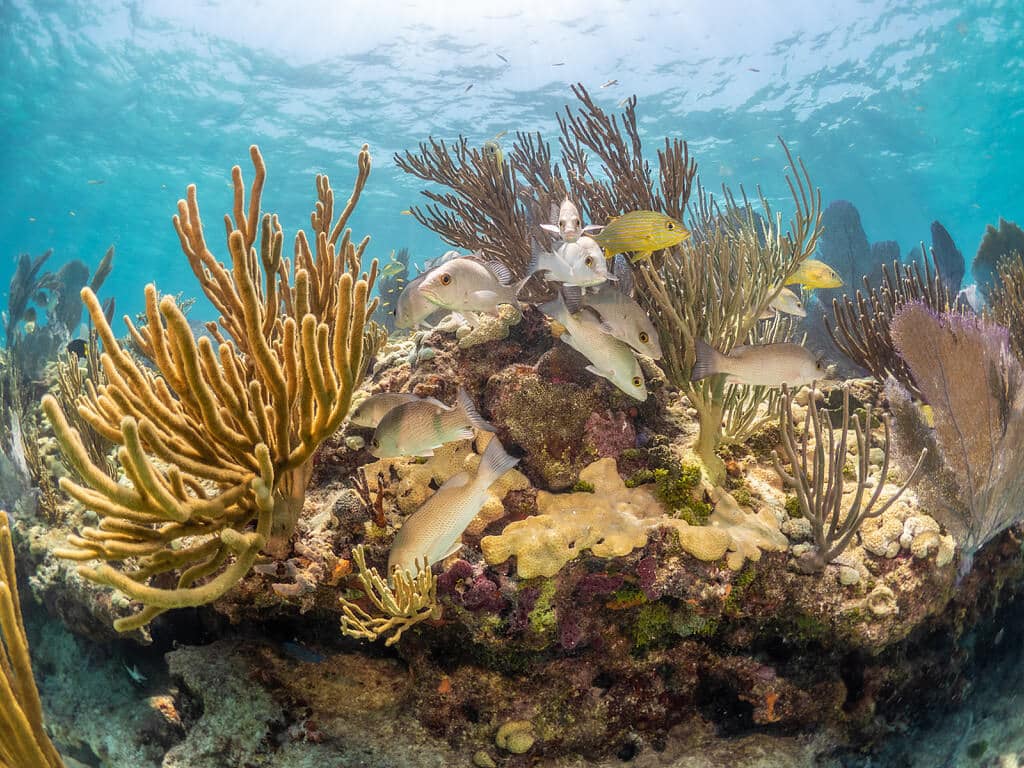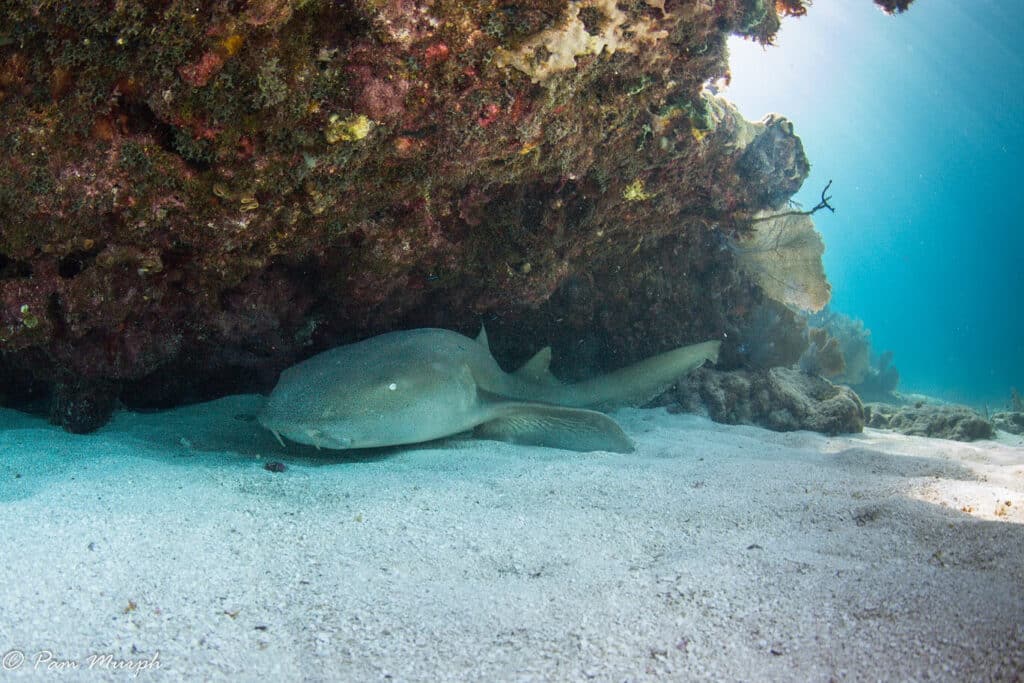Slip beneath the surface of Key West’s turquoise waters and you’ll have a front-row seat to one of the most vibrant underwater spectacles in the Florida Keys and all of United States. From schools of neon-striped fish weaving through coral to slow-gliding sea turtles, the marine life down here feels straight out of a nature documentary. So, what marine life can you see scuba diving in Key West? Whether you’re chasing the thrill of a shark sighting or simply want to float past delicate coral formations, the variety will catch you off guard in the best way.
You can expect to see different life throughout the year. With a little timing and a bit of luck, you’ll witness rare encounters and seasonal showstoppers. Ready for a sneak peek? Let’s dive into the details including reef fish, turtles, corals, and some jaw-dropping seasonal surprises all await you.

Key West Scuba Diving Overview
There’s a reason Key West ranks high on every diver’s bucket list. Sitting at the end of the Florida Keys, it’s home to North America’s only living coral barrier reef which is protected by the Florida Keys National Marine Sanctuary. A marine metropolis that brings stunning visibility and gentle currents. Many days, you can gaze 40–100 feet into the blue, with water temperatures hovering from the high 70s to mid-80s °F. No need for thick wetsuits here. It’s more likely you’ll be rolling sleeves up and soaking in the sun pre-dive.
Top dive sites like Sand Key, Western Sambo, and the historic Vandenberg wreck offer up-close looks at a huge range of marine life. At the reef, you’ll swim through corridors of coral bustling with fish. On shipwrecks, you can spot larger pelagic species cruising for snacks. No matter your skill level, there’s a dive site for you and each promises its own highlights.
Reef Fish Guide
Let’s start with Key West’s reef fish. These pint-sized powerhouses are impossible to miss and always doing something entertaining.
-
Parrotfish: Chunky bodies, beaked noses, and scales that shimmer like confetti. Their distinctive chomping helps keep the coral clean.
-
Angelfish: Queen angels and French angels glide through the reef with yellow, blue, and electric-purple markings. These elegant swimmers are both common and camera-friendly. Beautiful!
-
Snappers and Groupers: Just when you’re scanning the coral, a curious snapper or grouper might cruise past. Keep an eye out for Nassau groupers with their rugged stripes.
-
Wrasse, Butterflyfish, Grunts: Small but mighty, these darting species weave through coral branches and add pops of color wherever they go.
Tip from the Captain: Hover calmly and let the fish come to you. Sometimes the most memorable encounters happen when you pause to just look around.
Sea Turtles in Key West
If you’re after something bigger, keep your fins crossed for Key West’s frequent sea-turtle visitors. On a typical dive, you might lock eyes with:
-
Loggerhead turtles: The big ones. Those broad, dinosaur-like heads are unmistakable.
-
Green turtles: Sleek and streamlined, often grazing on seagrass patches along sandy bottoms.
-
Hawksbill turtles: Slightly more reclusive and prized for their pointed beaks and beautifully streaked shells.
Turtle sightings peak from May to September, when females come ashore to nest. It’s awesome to spot one rising for air or gliding along the reef during a calm summer morning. Many dive shops support turtle-friendly practices and partner with the Sea Turtle Conservancy to promote conservation. Ask your guide how you can help out, even as a visitor.

Coral Identification & Reef Ecosystem
A dive here wouldn’t be complete without time spent admiring coral. While you don’t need to be an expert, it’s cool to know some names and understand a little bit more about each one.
-
Brain coral: Large, round, and ridged like a human brain. Often home base for tiny crabs and shy fish.
-
Elkhorn coral: Looks like branches of deer antlers waving just below the surface.
-
Staghorn coral: Spindly, branching clusters often found deeper down.
Not sure how to spot a healthy coral? Look for bright colors, ample fish traffic, and no fuzzy algae buildup. Unfortunately, stressed corals appear pale, slimy, or even broken off. As a Blue Star Operator, Captain Hook’s Dive Key West takes coral preservation very seriously. It’s important to do your part and understand how to help keep the ecosystem healthy.

Shark Sightings on Key West Dives
If your dream dive includes a heart-thumping glimpse of a shark, you’re in luck. Shark sightings do happen in Key West, but don’t get too nervous. Nurse sharks are most common.
-
Nurse sharks: Often resting under ledges or cruising the sand, these gentle souls tend to ignore divers entirely.
-
Reef sharks: Sleek, fast, and surprisingly graceful, they make exciting, but safe appearances.
-
Hammerheads: Rare, but definitely an “I’ll never forget this” event if one swims by!
Other Fascinating Creatures
Every so often, you’ll come face-to-face with something truly unexpected. These are some of the most fun creatures to see.
-
Dolphins: Sometimes pods swim along with the dive boat. Glimpsing them underwater is rare but pure magic.
-
Spotted eagle rays: Graceful, dotted wings “flying” in formation over sandy channels.
-
Moray eels: Green morays peeking from coral alcoves, opening and closing their jaws as they “breathe.” Be careful reaching into holes!
-
Crustaceans (lobsters, crabs): Night dives bring out the wild side. Look for spiny lobsters crawling on the reef.
When you do spot these creatures, remember you’re a guest in their home. Keep hands off, flashlights dimmed, and give plenty of space. Key West’s marine life thrives thanks to protected areas and ongoing local conservation programs.
| Season | Months | Marine Life Highlights |
|---|---|---|
| Winter | December–February | Grouper spawning peaks, and visibility is superb after cold fronts. |
| Spring | March–May | Spiny lobsters, curious nurse sharks, and schooling baitfish prepping for the season ahead. |
| Summer | June–August | Prime time for sea-turtle nesting and hatchlings. Parrotfish and angelfish pop with extra color. |
| Fall | September–November | Juvenile reef fish swarm the corals. Eagle rays and some shark species migrate through. |
Tip from the Captain: Plan your dives around marine-life migrations and spawning events. Your crew might have some good tips. Chat them up before your trip to find out what’s currently making waves.
Frequently Asked Questions (FAQs)
What is the best time of year to see the most marine life in Key West?
June through September offers the highest diversity. Sea turtles, brightly colored reef fish, sharks, and rays. Winter brings good visibility but choppier seas.
Can beginners see a lot of marine life on easy dives in Key West?
Yes. Most of Key West’s reefs lie in shallow water -15 to 30 feet deep – so even novice divers will bump into plenty of colorful fish, coral, and other sea life.
Is it common to see sharks while scuba diving in Key West?
Mostly nurse sharks and some reef sharks. Don’t stress! They’re more interested in the local fish than in divers. Many visitors say shark encounters become the highlight of their trip.
What should I do if I encounter a sea turtle or large marine animal?
Stay calm, hold your position, and admire from a respectful distance. Don’t block their path or try to touch them. Let their natural behavior unfold. Most marine life has no interest in you.
Are there endangered species I might see while diving in Key West?
Yes, both elkhorn and staghorn corals are protected, and several local turtle species are endangered. Spotting one is a privilege. Help preserve these encounters by following reef-friendly diving guidelines.
Plan Your Ideal Key West Dive Adventure
Key West’s underwater magic isn’t just in the photos. I’s right there for anyone ready to jump in. Every dive has a story. Combine that with guidance from local dive operators and respect for the ecosystem, and you’ll leave with lifelong memories.
When you’re ready, local Key West dive shops can set you up, answer your questions about gear or wildlife, and even connect you with marine-conservation groups. If you’re thinking about what marine life you can see scuba diving in Key West, just know, it’s more than you think, and there’s always another surprise waiting just beneath the waves.
